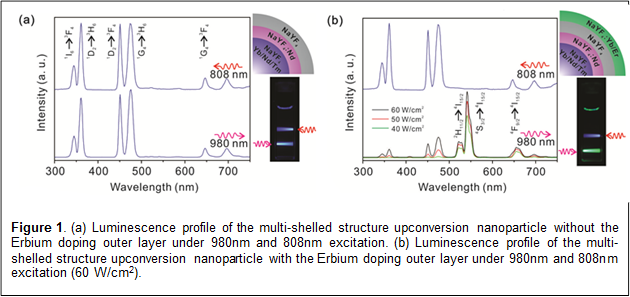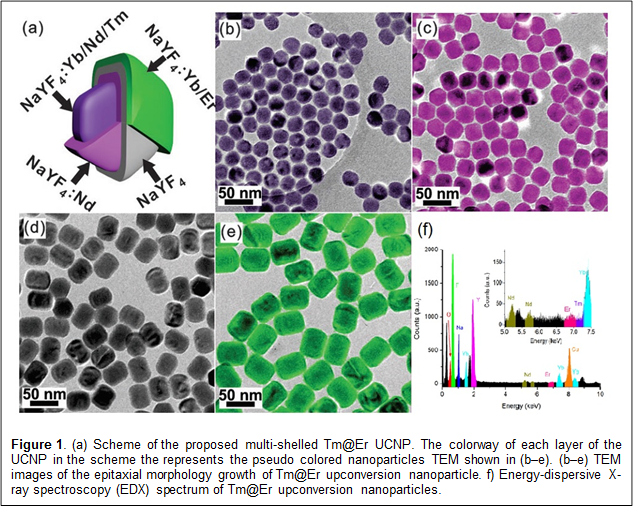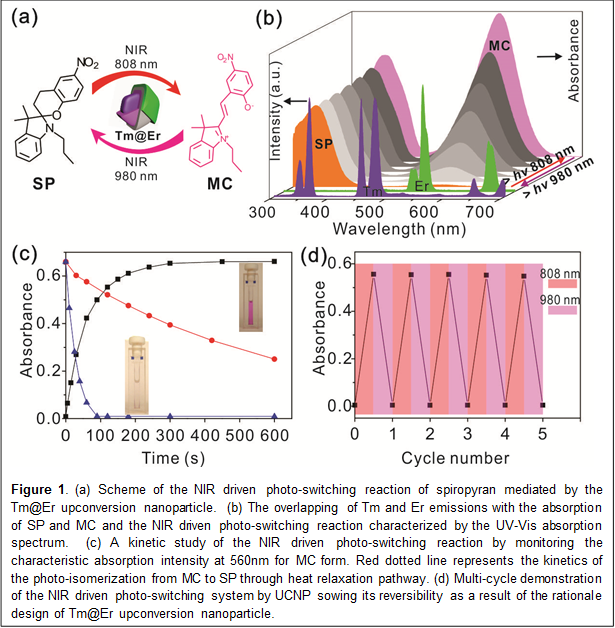Reports: ND1055869-ND10: Photochemical Control of Molecular Optical Switches Using Multicolor Upconversion Nanoclusters
Ki-Bum Lee, PhD, Rutgers, the State University of New Jersey
The primary goal of this proposal is to develop a multicolor upconversion nanoparticle (UCNP) platform, capable of orthogonally respond to 808 nm and 980 nm excitation wavelengths with ultraviolet and visible emissions that can be used to toggle the photo-isomerization reaction of spiropyran. Due to the significant role of photo-switching molecule for studying and understanding dynamic systems, this research provides insights into surface wettability, fluid transport, charged particle mobility, particle aggregation, and heat transfer, which are of great significance to petroleum researches, such as oil transportation and oil emulsification.
For this purpose, we have developed a novel multi-shell UCNP Tm@Er structure, shown in Figure 1a, by adopting and modifying a reported NaYF4 nanocrystal synthetic procedure. The epitaxial morphology growth has been characterized through transmission electron microscopy (TEM), from 25nm core to a final 41nm¡¿52nm nanocrystal (Figure. 1b-e). Since the upconversion luminescence efficiency highly depends on the lanthanide elements (Erbium, Thulium, Ytterbium, and Neodymium) doping, we utilized the energy-dispersive X-ray spectroscopy (EDX) to confirm the elemental composition of the synthesized Tm@Er UCNP.

The photoluminescence properties of the synthesized nanoparticles were characterized as shown in Figure 2. Specifically, the blue luminescent core of the Tm@Er upconversion nanoparticle emitted typical Tm3+ peaks under 808nm and 980nm laser excitations (Figure 2a). While only the Tm@Er upconversion nanoparticle showed typical Tm3+ emissions when irradiated with 808 nm excitation, and both Tm3+ and Er3+ emissions are present in the luminescence profiles under 60W/cm2 980nm excitations (Figure 2b). By decreasing the 980nm excitation power density to 40 W/cm2, a spectrally pure emission of Er3+ in the luminescent shell was observed. Therefore, we could conclude that the emission profile of the Tm@Er can be selectively modulated by different external stimuli (808nm and 980nm) from rationale designs of the photon inert shell and the cross-relaxation of the Nd3+ shell. To further demonstrate the design rationale, we constructed a control core-shelled nanoparticle without the photon inert shell. The control nanoparticle did not show distinct emission profile shift between the 980nm and 808nm nanoparticles due to the massive energy migration between the luminescent core and the luminescent shell.
Under ultraviolet irradiation, the colorless spiropyran (SP) form will transform into the colored isomer merocyanine (MC) form. Under visible light irradiation or heat relaxation, the reverse photo-isomerization will happen from MC form to the SP form. Since the typical Tm3+ emission has an UV emission peak at 365nm and Er3+ emission has a 530nm green emission, which overlaps well with SP's UV absorption maximum at 342nm (THF/Methanol 9:1 v/v) and the MC's visible absorption maximum at 560nm, the photo-switching of spiropyran molecule would be feasible using the Tm@Er UCNP with 808 nm and 980nm lasers respectively (Figure 3a). To prove this concept, we demonstrated the NIR-based two-way photo-switching of spiropyran as shown in Figure 3b and Figure 3c. Specifically, in the mixture of SP and Tm@Er, irradiation of 808 nm drove the photo-isomerization reaction from SP to MC, characterized by the absorption spectrum marked by the generation of the 560nm absorption peak of MC (Figure 3b). In addition, an apparent solution change was observed from colorless (SP) solution to pink (MC), as shown in the picture in Figure 3c. The NIR driven photo-switching kinetics was further studied by recording the development of the absorption peak intensity at 560 nm (MC) with reaction time increment. 92% conversion efficiency could be achieved with 808 nm (40 W/cm2) excitation in 120s. The reverse photo-isomerization reaction from MC to SP was also studied by monitoring the 560 nm visible absorption band using 980nm excitation, resulting in a colorless solution as shown in Figure 3b and Figure 3c. Furthermore, we also tested the recyclability of the NIR driven photo-switching system (Figure 3d). By monitoring the characteristic absorption peak of MC at 560nm, we irradiated the SP and Tm@Er upconversion nanoparticle solution alternatively with low power density 808nm and 980nm excitations, showing a more than 90% of the interconversion efficiency between the SP and MC form after 5 cycles of the isomerization reactions. In all, we have successfully demonstrated the NIR driven spiropyran photo-switching reaction with Tm@Er upconversion nanoparticle as a NIR to UV-Vis converter.
In summary, we have designed and synthesized a novel upconversion nanoparticle system, Tm@Er, to utilize orthogonal NIR excitations to drive the photo-switching reaction between SP and MC in a reversible manner as a proof of concept. Further research will focus on surface wettability alteration based on the hydrophilicity and hydrophobicity difference of SP and MC forms, which is of significance to oil transportation studies.













